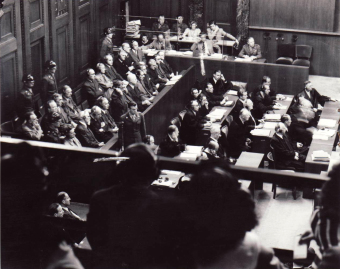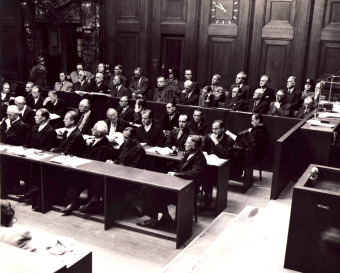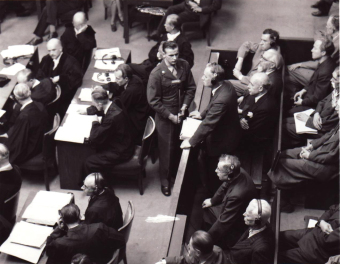The Main Trial in the I.G. Farben Case in Nuremberg (Case VI)

© National Archives, Washington, DC

© National Archives, Washington, DC

© National Archives, Washington, DC
The main hearing in the I.G. Farben Trial in Nuremberg was opened on August 27, 1947, with an opening statement by Telford Taylor, the chief of counsel for the prosecution. The 12 members of prosecution counsel were opposed by 87 members of defense counsel, with both sides assisted by associates and staffs. The Tribunal convened on a total of 152 separate days, and 102 witnesses for the defense and 87 witnesses for the prosecution were called.[1] The defense saw itself confronted with manifestly incriminating documents, which seemed difficult to rebut. Therefore a two-part strategy was adopted: First, the defendants agreed beforehand, with Fritz ter Meer acting as mediator, on a line of depoliticized description of the structure of I.G. Farben: they would say that they had had nothing to do with the decisions at issue in the trial; that the standards and in particular the utilization of concentration camp prisoners in Monowitz were determined by the political “control stand” and forced on I.G. Farben; and that resistance was impossible. Georg von Schnitzler’s initial admission that he had participated diverged from this line, but he withdrew his confession under pressure from his fellow defendants. Second, based on that, the members of defense counsel constructed strategies for defense against the charges with regard to each individual accused.
This line of action panned out, for the most part: As the court by the third day already had made known its displeasure at the prosecution’s lengthy explanations, the defense succeeded in excluding the “overall I.G. context […] after a few days.”[2] At the same time, the political climate also played into the hands of the defense: As the trial began, the Cold War reached its highpoint. In addition, I.G. Farben had powerful political and economic supporters in the United States. This led to “flagrantly anti-Semitic”[3] attacks on the prosecution team, in particular on Josiah E. DuBois, to rants in the conservative U.S. media about having “too many Jews” as prosecutors, and even to investigation by a judge to learn “whether DuBois is a ‘Jew.’”[4]
While the defendants basically denied all responsibility for and frequently even all knowledge of the crimes with which they were charged, or, in the case of count three, which referred to the events in Monowitz, claimed to have done everything in their power to improve the prisoners’ living and working conditions, the witness victims vehemently contradicted them on precisely this point: Former prisoners and British prisoners of war had come to Nuremberg, faced direct examination and cross-examination in November 1947, and vividly portrayed the brutal reality in the camp and at the I.G. Farben construction site. Defense counsel had little with which to counter that; the defense attorneys limited themselves to relativizing the individual responsibility of the accused and to invoking Befehlsnotstand, “orders from above.” It was not easy for the prosecution to ascribe individual elements of the offense to the agents of the firm; on essential points, however, defense counsel did succeed in rebutting earlier statements of the accused made under cross-examination and in proving the concern’s part in preparations for war in the context of the Four Year Plan. The main trial ended on May 28, and the judgments were delivered on July 29 and 30, 1948.
(SP; transl. KL)
















